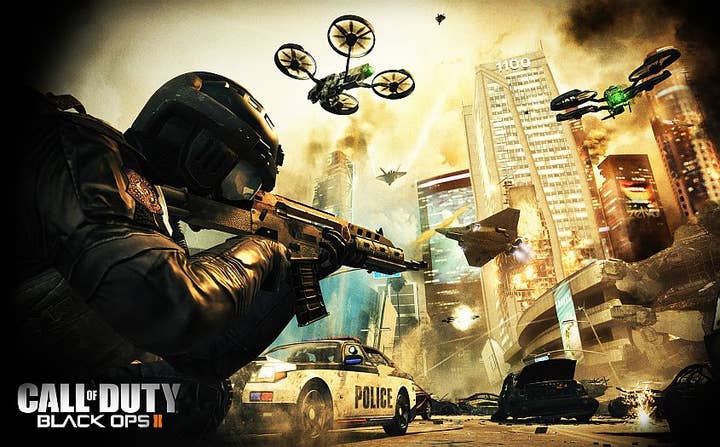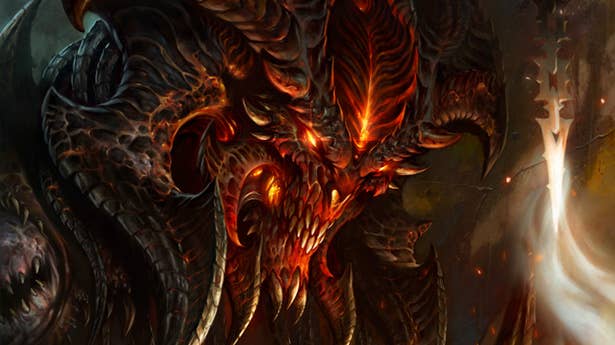Activision: big fish in a shrinking pond
As console sales continue to decline across the market, concerns are raised for 2013 and beyond
Activision's CEO Bobby Kotick was clearly pleased to be announcing an excellent quarter for the company, as Activision beat expectations for both revenues and profits. Revenue was up to $841 million for the quarter, compared to $741 million last year, and earnings per share rose to $0.20 from $0.13 cents. Digital revenues (in Activision Blizzard's case, mostly from World of Warcraft) represented 51 percent of the company's total net revenues.
Kotick cited the strong performance of the company's four main franchises: World of Warcraft, Call of Duty, Diablo III and Skylanders. With the pre-orders rolling in for Call of Duty: Black Ops II and Skylanders: Giants off to a good start, Activision raised its guidance for the year, looking for a record total of $4.75 billion for the year, with a 33 percent margin (also a record).

Kotick explained the company's strategy. “We also continue to strengthen our competitive position by doing what we do best: Staying focused on driving our business by prioritizing our biggest opportunities and not getting distracted by initiatives unlikely to result in the creation of great interactive entertainment and superior shareholder returns.” In other words, not investing heavily in things like mobile, social, cloud gaming or other efforts that don't currently account for huge profits. Mobile games are not yet a significant financial contributor, according to president Eric Hirshberg.
Then, Kotick sounded a cautionary note for next year. “While we have a promising pipeline of great games based on proven franchises, as well as exciting new products like our collaboration with Bungie, we recognize that duplicating this year's success will be difficult.”
Activision president Eric Hirshberg gave details of the company's view of the industry: “The retail trends that we've seen over the past few years are continuing this year, with the top five games in North America and Europe growing 15 percent including toys and accessories. However, this growth has come at the expense of the rest of the industry. While challenging, these trends play to our strengths, given our laser focus on our largest and best franchise opportunities, and our performance this year continues to validate that strategy.”
"We recognize that duplicating this year's success will be difficult"
CEO Bobby Kotick
In other words, Activision has done well while the rest of the industry has been shrinking. That sounds good for now, but if the shrinkage of the industry continues, doesn't that mean eventually Activision's revenues will shrink?
Hirshberg gave enthusiastic details of the success of Skylanders, which was the number one best-selling retail videogame franchise across North America and Europe if you include toys and accessories, and it's also become the number one selling action figure line. “In less than one year Skylanders has become one of the world's most popular kids brands, and is on track to become another billion dollar franchise for the company,” Hirshberg noted.
Activision has seen the retail space devoted to Skylanders boom. “The game shipped with high brand awareness and a more than 50 percent larger retail presence than last year. In North America alone Skylanders Giants has over 100,000 linear feet of shelf space and more than 10,000 interactive displays worldwide. We've also signed more than 100 licensing partnerships, which were chosen both to increase the brand's presence and its stature throughout the store,” Hirshberg said.
The earnings call moved into the question phase, where analysts were mostly unsuccessful at prying information out of Activision executives. Analysts repeatedly tried to get Activision to comment on next-gen consoles, or on developing for next-gen consoles, but the standard response was “We don't comment on that.”
Notable for the lack of mention were several of Activision's titles that were showcased earlier, like the Spider-man game and the Transformers game. It would seem that, like other publishers are finding, the lower-tier titles are not generating great numbers anymore.
The earnings report was excellent, with record profits to report and the fourth quarter looking strong so far. Yet the shadows are gathering on the horizon. Activision is depending on its current hit franchises for the bulk of its revenue. World of Warcraft, Call of Duty, Diablo III and Skylanders are all top performers that are propelling the company to record sales for 2012. Why can't those titles do the same thing for 2013?
"In North America alone Skylanders Giants has over 100,000 linear feet of shelf space and more than 10,000 interactive displays worldwide"
President Eric Hirshberg
The industry is the problem for Activision, or more precisely, the console portion of the industry. The high point of console game sales was 2008, and every year since then sales have been lower. This year console game sales (collectively, at US retail stores) have been running about 25 percent lower than last year every month. Publishers have made some of that up through the sale of DLC, which is not tracked by the NPD monthly figures.
Currently the Wii U will be replacing the Wii, but it's not at all certain that Wii U sales will be equal to what Wii sales were last year. That would be difficult given that the Wii U is more than twice the price of the Wii. In any case, the installed base is going to be tiny compared to the Wii for years, even if the Wii U sells quite well. There's no firm date for the introduction of next-gen consoles from Sony and Microsoft, but usually new consoles are introduced for the holiday selling season towards the end of the year. In the best case, then, a new console from Sony and a new console from Microsoft might be introduced a year from now, and each would generate a couple months of sales.

Two to three months of sales of next-gen consoles would not create much of an installed base before the end of 2013; perhaps a few million. Even the best-selling games on those new platforms might be only a million units or so. That sounds like a lot, but when you realize that Call of Duty: Black Ops II will probably generate 10 million unit sales before the end of this year, 1 million units isn't going to make a big financial difference.
The shape of Activision's problem for 2013 begins to emerge. Console game sales in general for 2013 are likely to be even lower than 2012, and console hardware sales will likely drop as people anticipate new consoles (or migrate to online or mobile games). New consoles, if they arrive next year, won't make a big difference to 2013 sales of game software. Therefore, exceeding 2012 sales is going to be difficult, even with a slate of releases that is similar.
The console problem hits two of Activision's four main franchises: Call of Duty and Skylanders. What about World of Warcraft and Diablo III? Both have issues to deal with. World of Warcraft is still holding on to a subscription model, as almost the entire MMO business shifts to free-to-play. The release of Mists of Pandaria has boosted subscriber numbers back above 10 million, but for how long? The tale of WoW expansions has been that each successive one seems to take less time for players to complete. After the big rush, we can expect more fall-off in subscribers if past performance is a reliable guide. While Blizzard is trying to put out expansions more swiftly, it seems unlikely that another WoW expansion will make it out in 2013. In a year's time, subscriber numbers will likely be less than 9 million if the trend lines from the past continue. Remember, Blizzard accounts for half of Activision Blizzard's profits. A drop in subscribers to WoW has large implications for Activision's financial performance.
"Activision is justifiably cautious about the financial picture for 2013, and is setting expectations for a lower revenue number"
Diablo III has sold over ten million copies, but the product doesn't seem to have created the vibrant online economy that Blizzard was hoping for. The game still has balance issues, and doesn't seem to be attracting players for long-term play once they've completed the game. While it will continue to sell, it's probably not going to be a major factor next year. Hopefully Activision can get a Diablo III expansion out in 2013, though no date has been set. As for Diablo IV, we can logically expect that sometime after 2020, unless development is sped up a bit.
As for new IP, the deal with Bungie may produce a product in 2013... or it may not. The issue is complicated by the potential introduction of a new generation of consoles with substantially greater horsepower. Does Bungie design to that level, and create a lesser version for old consoles? Perhaps, but the marketing of such disparate versions could get tricky. It's not at all clear whether new consoles will be a hit, either; many observers think that the next generation of consoles will be the last generation of consoles, and it won't sell as well as the last one. That raises serious long-term issues for Activision's console-reliant strategy.
There's also the Titan project underway at Blizzard, but again there is no guidance on when that might arrive (or even what it is, exactly). Perhaps it can replace or supplement the (likely) declining World of Warcraft revenue stream, or perhaps not. It seems logical to assume that Titan wouldn't be arriving until late in 2013 (since there has been no information released whatsoever) and thus would have slight impact for the fiscal year. More than likely, though, Titan is going to be something to look for in 2014 or even beyond, given how long Blizzard usually takes to polish a game.
All of that analysis shows why Activision is justifiably cautious about the financial picture for 2013, and is setting expectations for a lower revenue number. The picture doesn't look so good for 2013, but when you try and look ahead into 2014 it gets even murkier. If the next console generation doesn't start to produce some serious sales by then, console game revenues will be even more constrained. Tablets, smartphones, and connected TVs may become a significant revenue source for games by that timeframe. Activision is just beginning to launch its mobile game division, though. Can the company ramp up its franchises to meet the challenges of new platforms by then?
Remember, it's not just the hardware platforms that are changing; it's the business models. Shipping discs in boxes to retail stores is generating less revenue each year, overall, and that trend will continue and probably accelerate. Free-to-play games, ad-supported games, virtual goods - all of these models are increasingly important in mobile games and in online games. Activision's track record of success with new business models so far isn't very good; Activision has given up on the Call of Duty Elite subscription service after less than a year. (The service still exists, but Activision is no longer charging for it.) It's certainly possible to develop new business models, but when is Activision going to start?
"Activision is the big fish in a shrinking pond, but how fast will the pond dry up?"
One analyst asked if Skylanders would be another Guitar Hero: a franchise that rose swiftly and declined even faster. Hirshberg was quick to note that “We have a pipeline of spectacular innovation in development” for Skylanders, and express full confidence in the future of the product line. However, it's difficult to predict when consumers might fall out of love with a particular franchise. Some new IP might catch their fancy, or a mediocre product release might kill interest in future products. That's the danger of hanging your company's future on four key franchises; one could drop off at any time. Worse, more than one might fall down. That's why new IP is vitally important, as is exploring new platforms for existing IP. Those new revenue streams can add to success, or help preserve it when other properties suddenly lose their lustre.
Activision is the big fish in a shrinking pond, but how fast will the pond dry up? The company faces an interesting transition ahead. The comparison to Electronic Arts is an interesting one. EA has spent several years investing heavily in new technologies and platforms, buying companies and creating mobile and social games. This has hammered EA's profits and its share price. Meanwhile, Activision has mostly ignored new platforms and business models, and focused on optimizing its console and PC game business. Activision has piled up a string of hits and a considerable amount of cash (some $3.4 billion).
Now, though, the game industry is being forced into multiple transitions. New consoles that may or may not be successful will be arriving as the current generation of consoles sells less and less. Mobile and online games represent an increase in share of the market. Digital distribution is changing the nature of game design and the economics of the industry. Electronic Arts is arguably better positioned to thrive when new business areas boom, while Activision will need to adapt to new and unfamiliar business models.
Activision has some amazing brands and a good pile of cash to help it move into new markets, but the future doesn't necessarily arrive on a predictable timetable. Sometimes markets shift faster than expected. Sometimes an existing franchise may falter with a mediocre new game, or just a shift in consumer preferences. Activision's challenge for 2013 is to show that it can start succeeding with new business models and platforms in a substantial way. Otherwise, investors may begin to wonder where major growth opportunities are coming from if the console market continues to shrink.

